Display of a plurality of files from multiple devices
Patel , et al. Feb
U.S. patent number 10,216,365 [Application Number 14/872,035] was granted by the patent office on 2019-02-26 for display of a plurality of files from multiple devices. This patent grant is currently assigned to DROPBOX, INC.. The grantee listed for this patent is Dropbox, Inc.. Invention is credited to Ashish Chordia, Mark C. Dixon, Nichole C. Gabriel, Vivek Patel, Gibu Thomas.
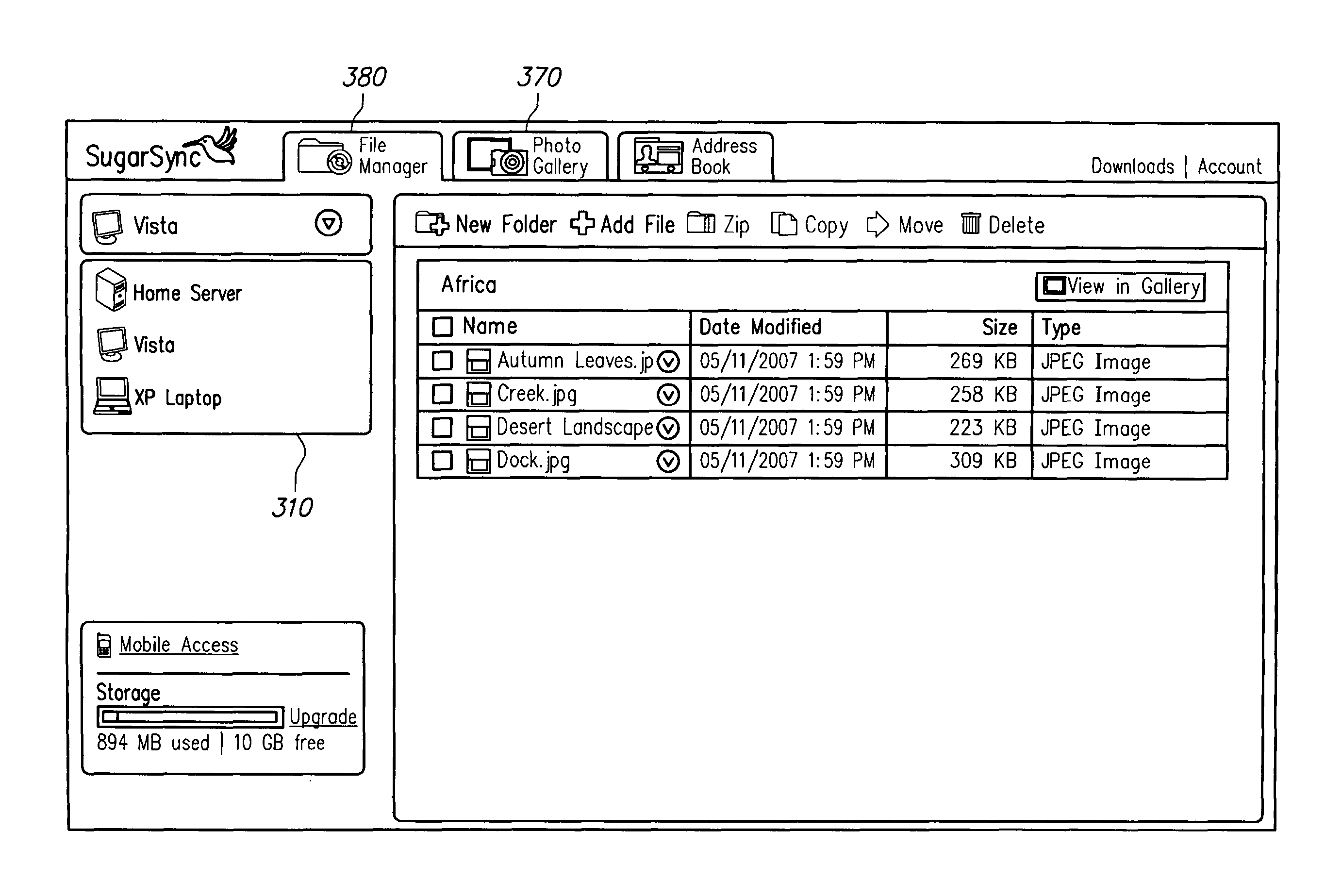

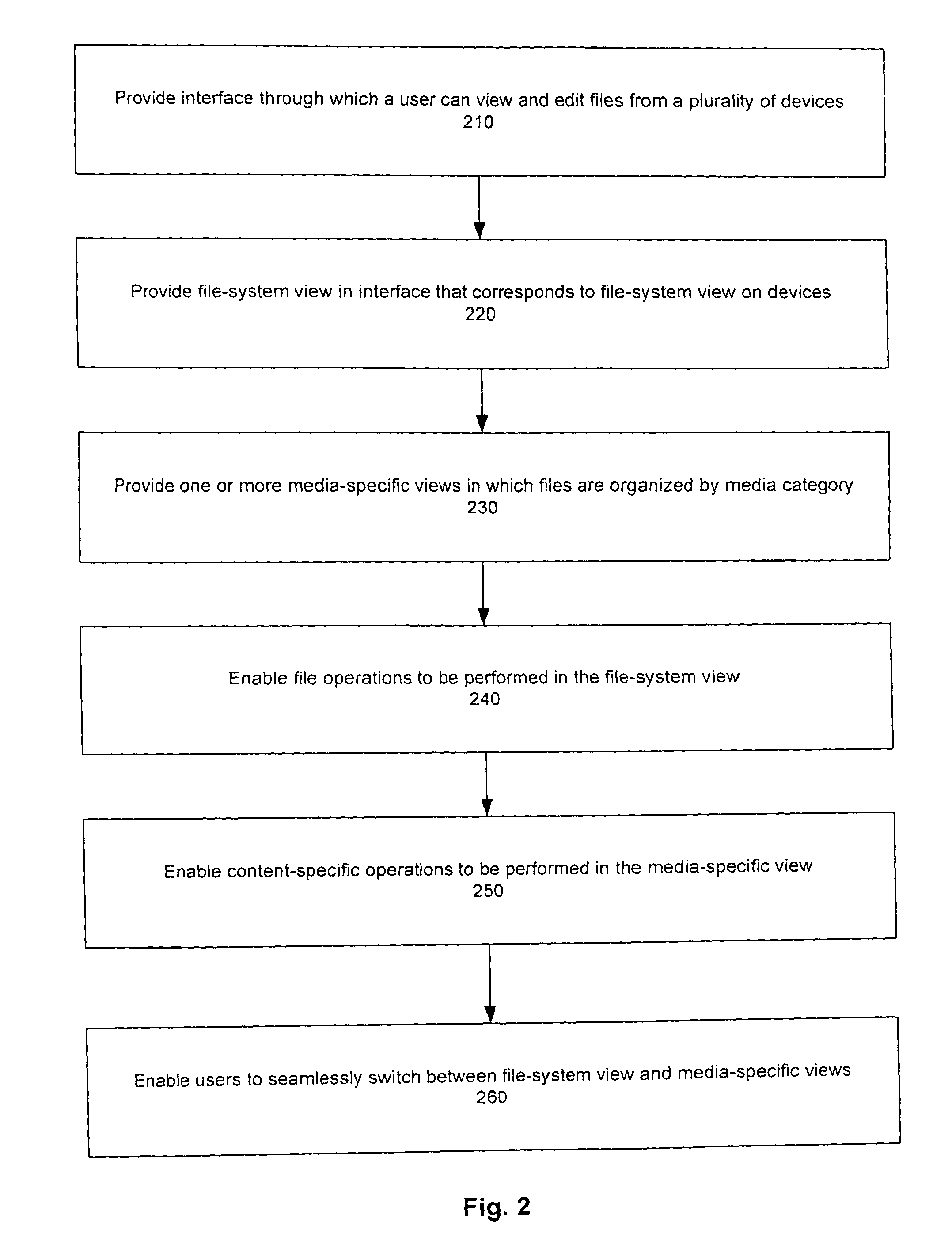
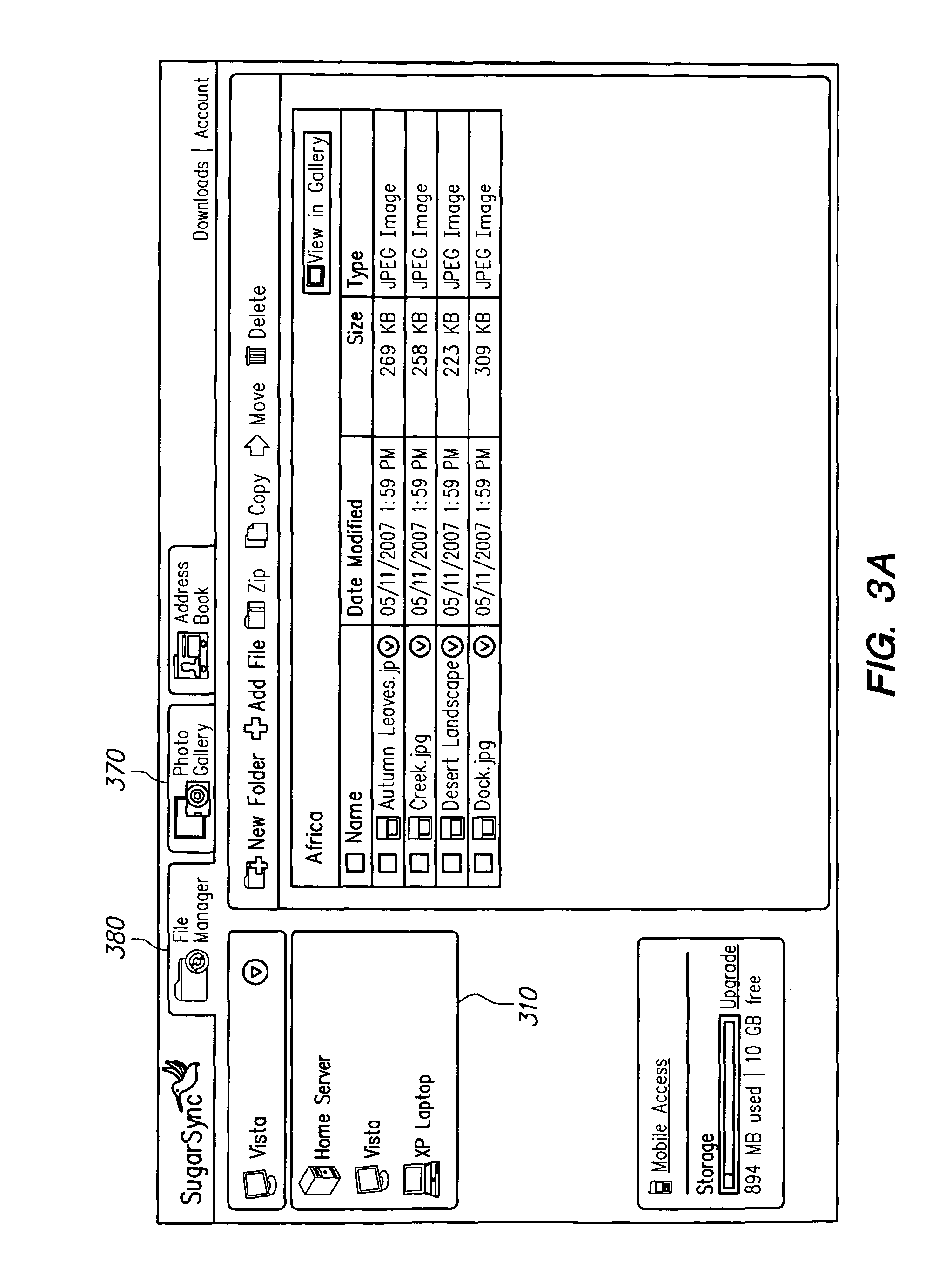
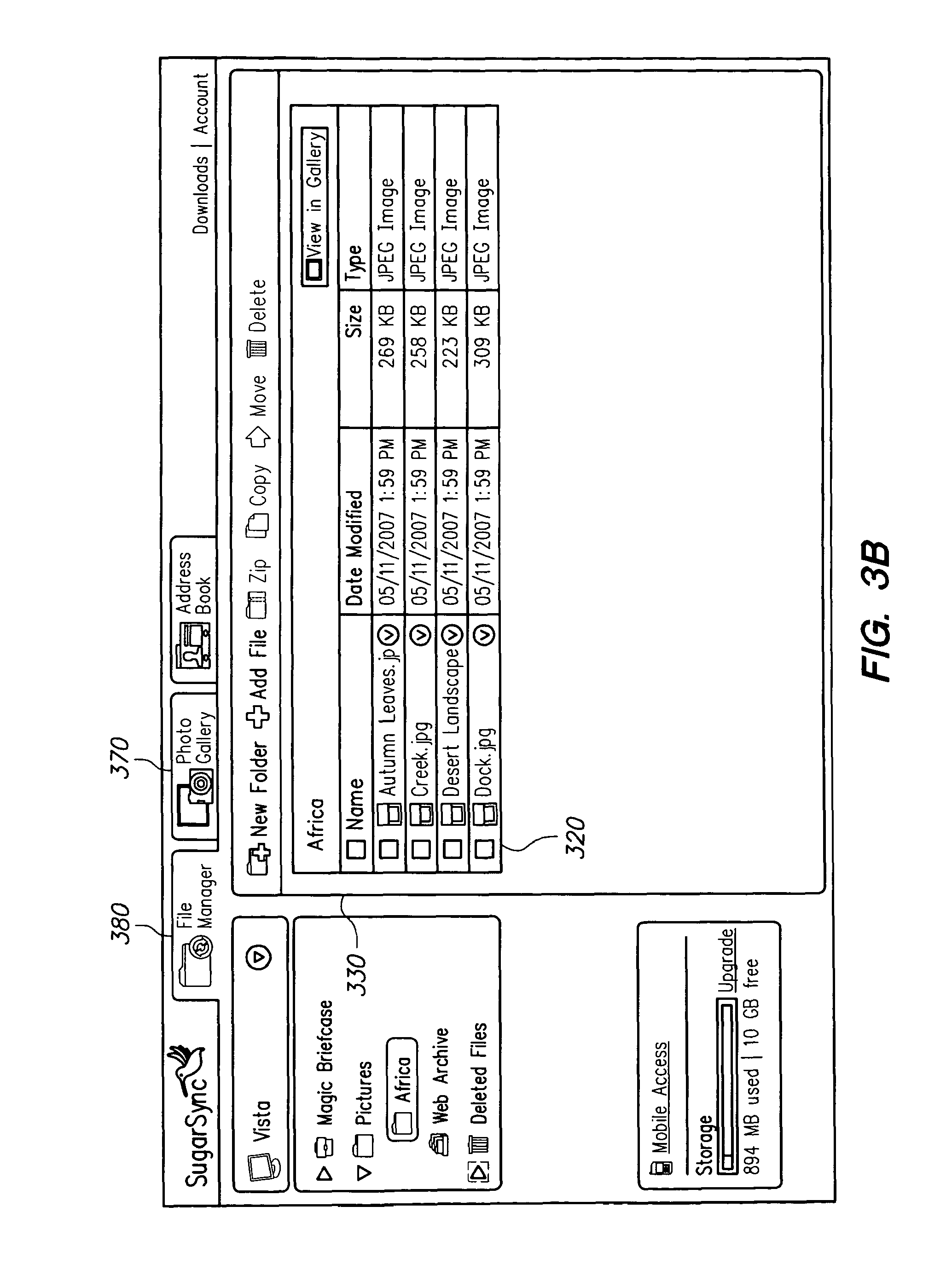
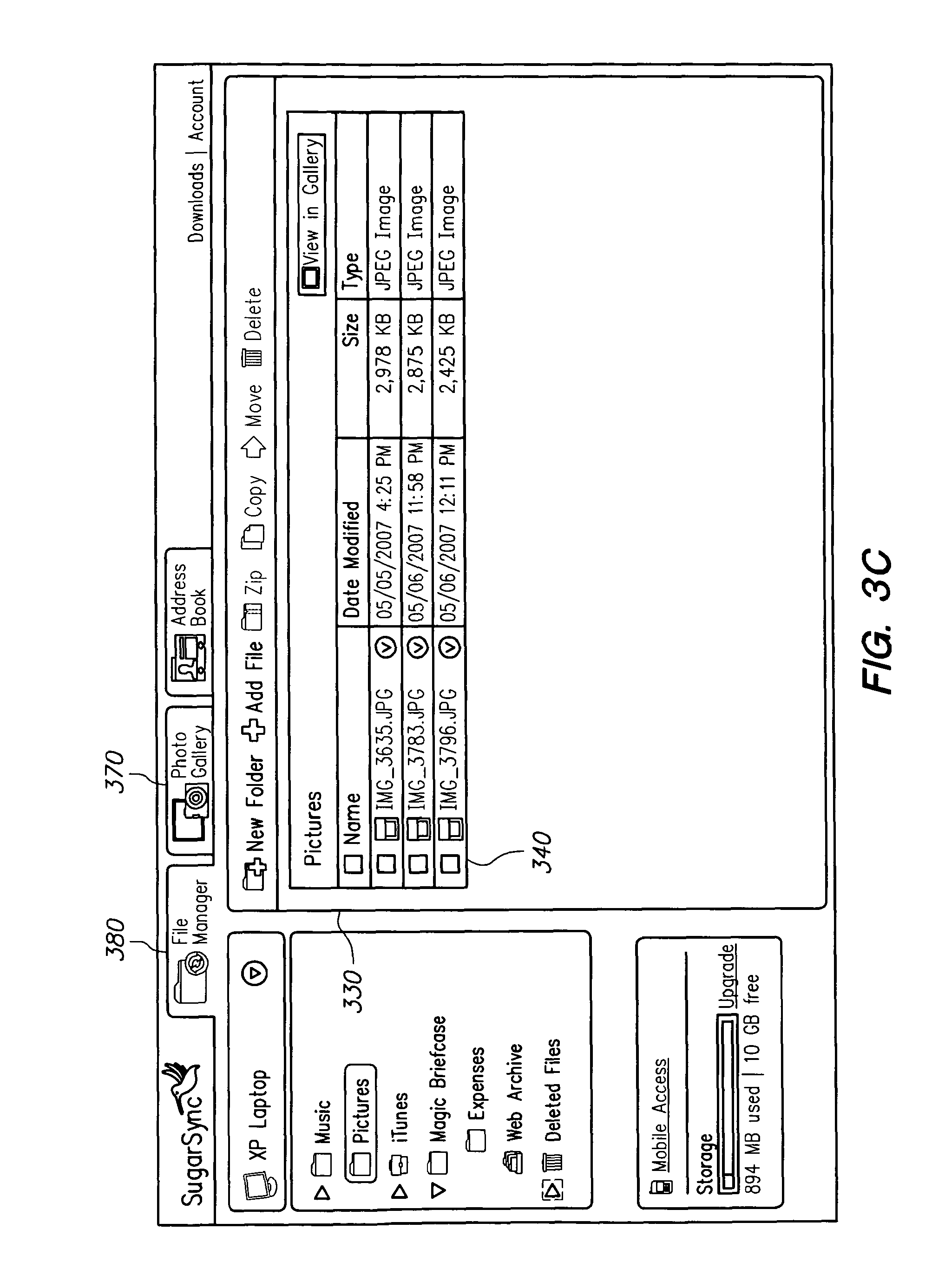
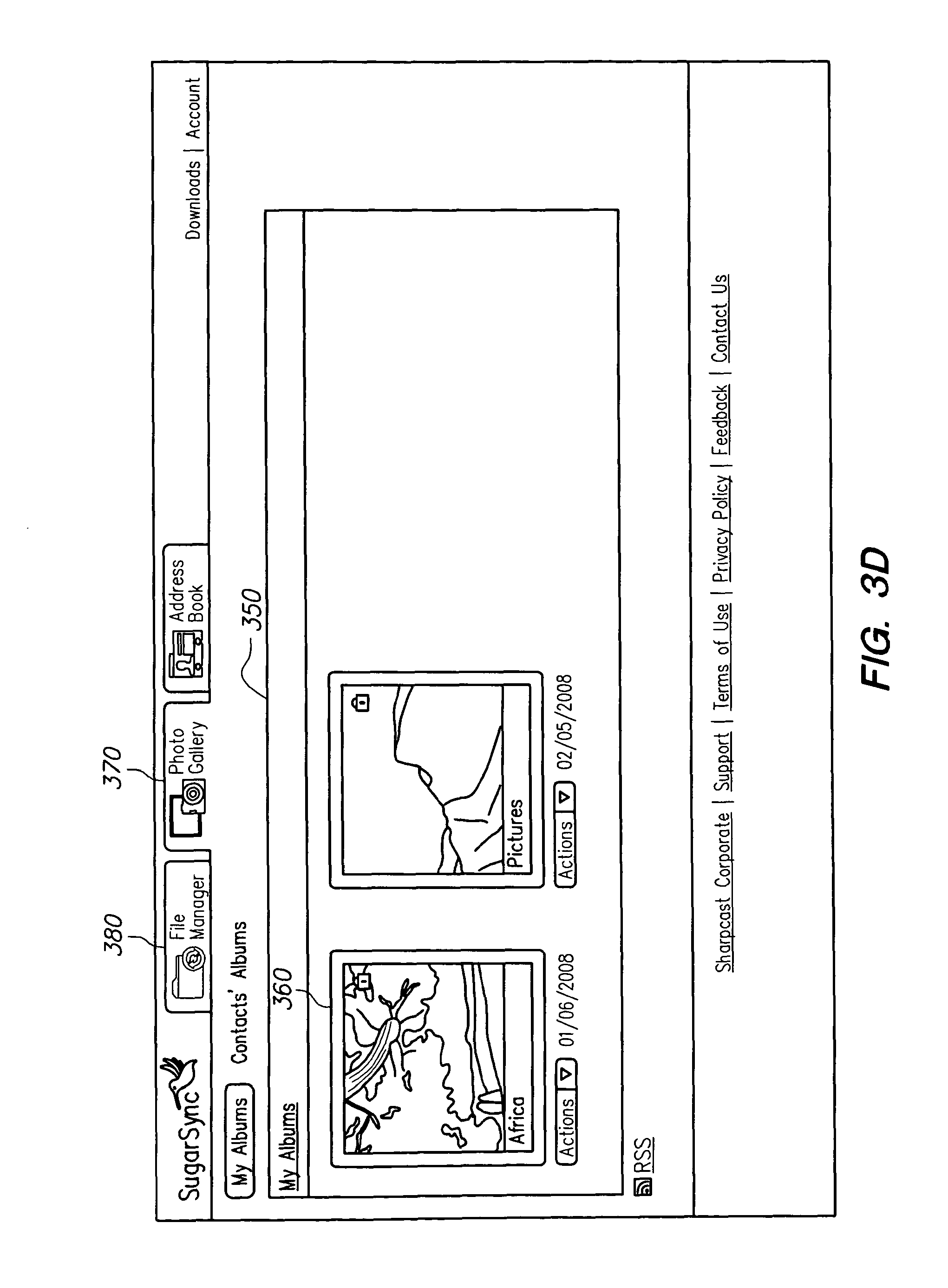
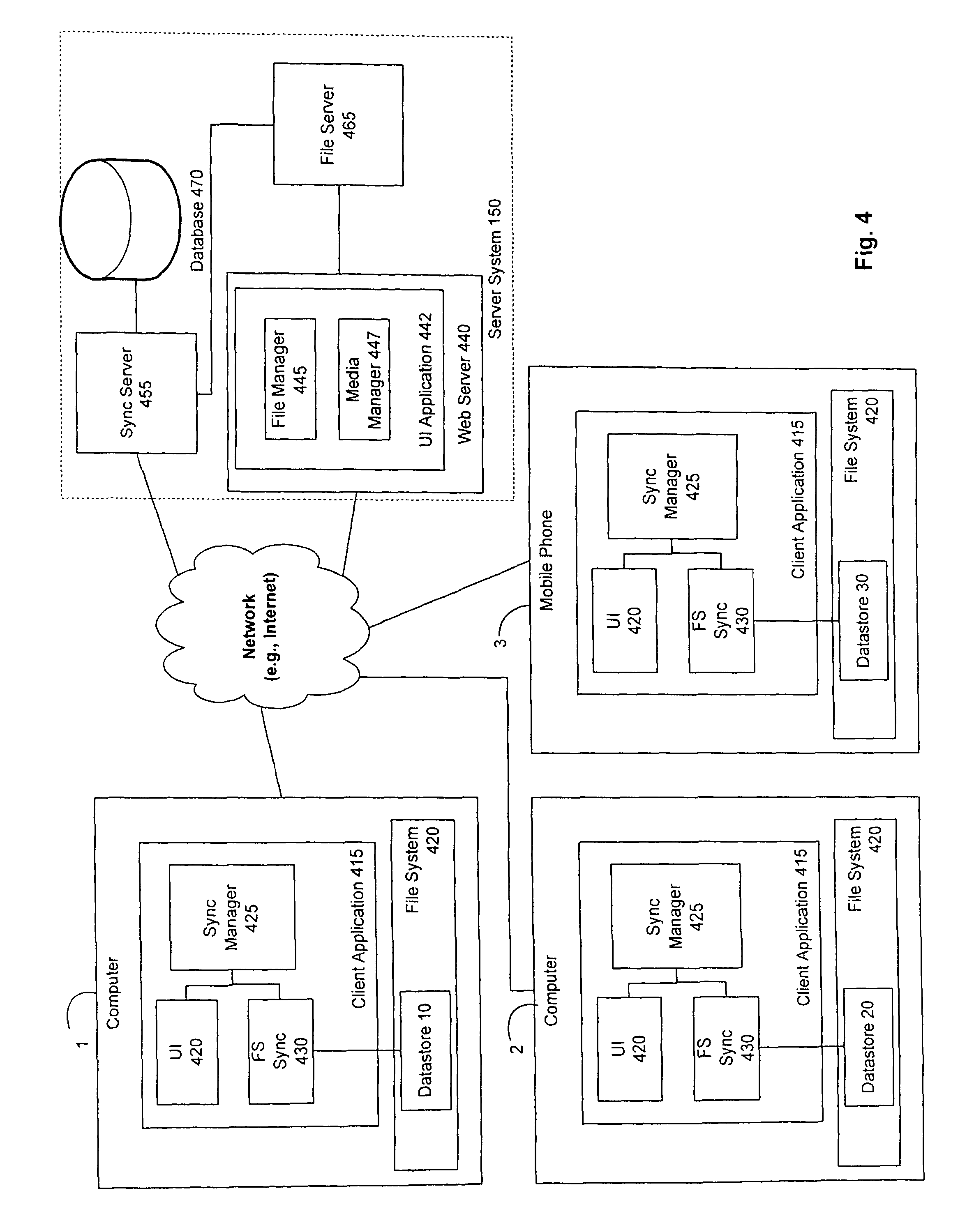

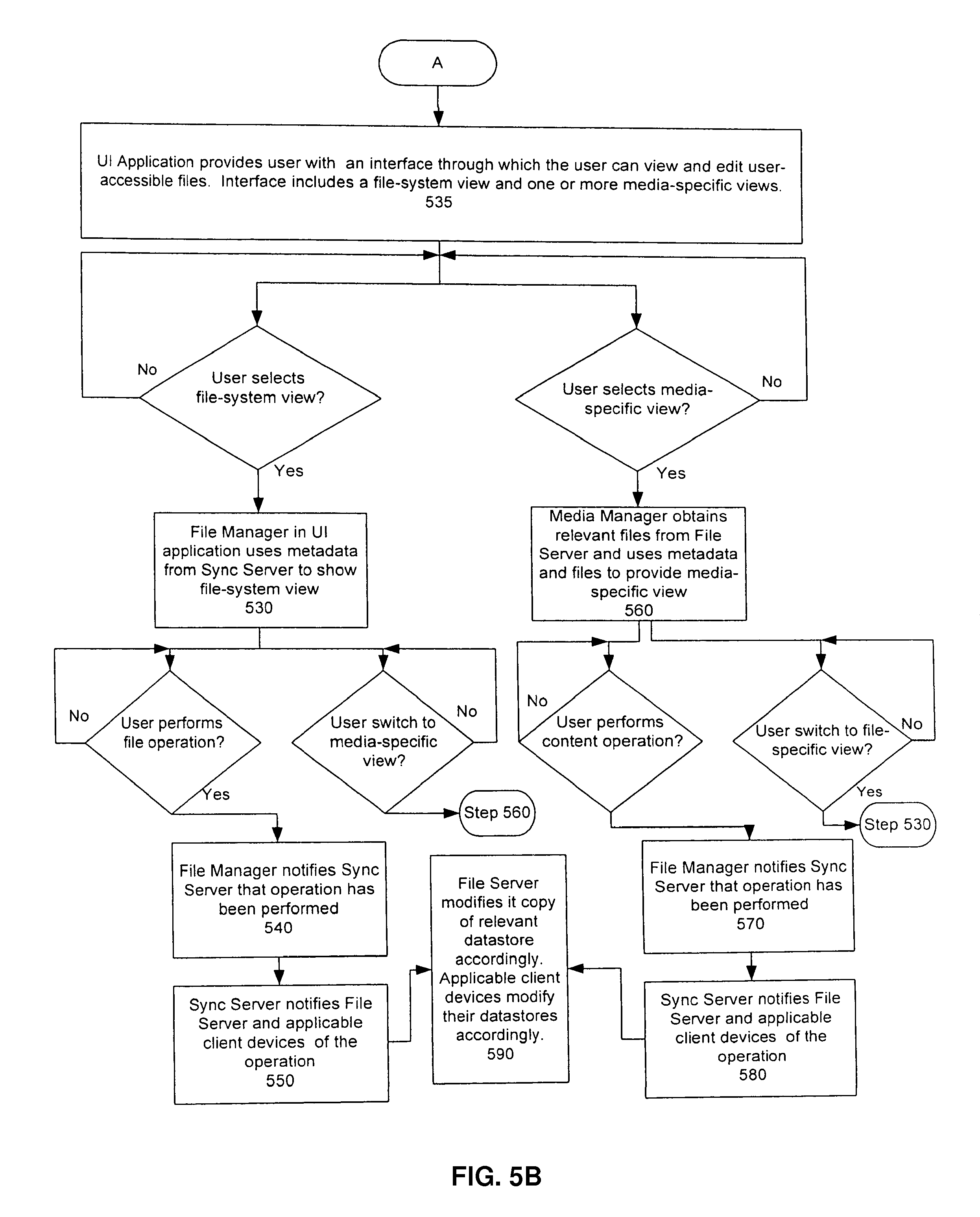
| United States Patent | 10,216,365 |
| Patel , et al. | February 26, 2019 |
Display of a plurality of files from multiple devices
Abstract
In a synchronization or back-up system that synchronizes and/or back-ups files from multiple computing devices, the present invention provides a method for (1) displaying files from multiple computing devices in a multi-view user interface and (2) enabling content and file operations to be performed on such files through the user interface. The multi-view interface includes a file-system view and one or more media-specific views. In the file-system view files are organized in the same way in which they are organized on the devices on which they are stored. The file-system view in the interface looks essentially the same as the file-system view on client devices. In the file-system view, users can perform file operations on files. In the media-specific view files are organized by media category. In one embodiment of the media-specific view, files are organized by metadata that relates to the files content. In the media-specific view, users can perform content operations on the files.
| Inventors: | Patel; Vivek (San Carlos, CA), Dixon; Mark C. (Redwood City, CA), Thomas; Gibu (San Francisco, CA), Chordia; Ashish (Santa Clara, CA), Gabriel; Nichole C. (San Francisco, CA) | ||||||||||
|---|---|---|---|---|---|---|---|---|---|---|---|
| Applicant: |
|
||||||||||
| Assignee: | DROPBOX, INC. (San Francisco,
CA) |
||||||||||
| Family ID: | 53038343 | ||||||||||
| Appl. No.: | 14/872,035 | ||||||||||
| Filed: | September 30, 2015 |
Prior Publication Data
| Document Identifier | Publication Date | |
|---|---|---|
| US 20160041707 A1 | Feb 11, 2016 | |
Related U.S. Patent Documents
| Application Number | Filing Date | Patent Number | Issue Date | ||
|---|---|---|---|---|---|
| 14682555 | Apr 9, 2015 | 9841875 | |||
| 12077533 | May 12, 2015 | 9032295 | |||
| Current U.S. Class: | 1/1 |
| Current CPC Class: | H04L 67/06 (20130101); G06F 3/04842 (20130101); G06F 16/40 (20190101); G06F 16/14 (20190101); G06F 16/48 (20190101); G06F 3/04817 (20130101); G06F 3/0482 (20130101); G06F 16/438 (20190101); G06F 11/07 (20130101); G06F 11/1448 (20130101) |
| Current International Class: | G06F 3/0482 (20130101); G06F 3/0484 (20130101); G06F 3/0481 (20130101); G06F 11/07 (20060101); H04L 29/08 (20060101); G06F 11/14 (20060101) |
References Cited [Referenced By]
U.S. Patent Documents
| 5862346 | January 1999 | Kley et al. |
| 6348932 | February 2002 | Nishikawa et al. |
| 6407750 | June 2002 | Gioscia et al. |
| 6636873 | October 2003 | Carini et al. |
| 6636888 | October 2003 | Bookspan et al. |
| 6904185 | June 2005 | Wilkins et al. |
| 7039723 | May 2006 | Hu et al. |
| 7103357 | September 2006 | Kirani et al. |
| 7139555 | November 2006 | Apfel |
| 7319536 | January 2008 | Wilkins et al. |
| 7321919 | January 2008 | Jacobs et al. |
| 7369161 | May 2008 | Easwar et al. |
| 7372485 | May 2008 | Bodnar et al. |
| 7441180 | October 2008 | Kaczmarek et al. |
| 7502795 | March 2009 | Svendsen et al. |
| 7576752 | August 2009 | Benson |
| 7680067 | March 2010 | Prasad et al. |
| 7707500 | April 2010 | Martinez |
| 7747596 | June 2010 | Bigioi |
| 7774326 | August 2010 | Arrouye |
| 7809682 | October 2010 | Paterson et al. |
| 7930270 | April 2011 | Tsang |
| 8181114 | May 2012 | Saka |
| 8321374 | November 2012 | Holt et al. |
| 8751604 | June 2014 | Liebman |
| 8949179 | February 2015 | Besen et al. |
| 9032295 | May 2015 | Patel et al. |
| 9841875 | December 2017 | Patel et al. |
| 2002/0003548 | January 2002 | Krusche |
| 2002/0013852 | January 2002 | Janik |
| 2002/0044159 | April 2002 | Kuroiwa et al. |
| 2002/0059604 | May 2002 | Papagan et al. |
| 2002/0065848 | May 2002 | Walker et al. |
| 2002/0066050 | May 2002 | Lerman et al. |
| 2002/0091697 | July 2002 | Huang |
| 2002/0099772 | July 2002 | Deshpande et al. |
| 2002/0129096 | September 2002 | Mansour et al. |
| 2003/0004952 | January 2003 | Nixon et al. |
| 2003/0014478 | January 2003 | Noble |
| 2003/0131098 | July 2003 | Huntington et al. |
| 2003/0159136 | August 2003 | Huang et al. |
| 2003/0218633 | November 2003 | Mikhail et al. |
| 2004/0024979 | February 2004 | Kaminsky et al. |
| 2004/0044732 | March 2004 | Fushiki et al. |
| 2004/0088420 | May 2004 | Allen et al. |
| 2004/0148207 | July 2004 | Smith et al. |
| 2004/0148375 | July 2004 | Levett et al. |
| 2004/0255253 | December 2004 | Marcjan |
| 2005/0044164 | February 2005 | O'Farrell et al. |
| 2005/0149213 | July 2005 | Guzak |
| 2005/0149481 | July 2005 | Hesselink |
| 2005/0165869 | July 2005 | Huang et al. |
| 2006/0052091 | March 2006 | Onyon et al. |
| 2006/0156239 | July 2006 | Jobs et al. |
| 2006/0184673 | August 2006 | Liebman |
| 2006/0242206 | October 2006 | Brezak et al. |
| 2007/0005581 | January 2007 | Arrouye |
| 2007/0005707 | January 2007 | Teodosiu |
| 2007/0043830 | February 2007 | Housenbold et al. |
| 2007/0156434 | July 2007 | Martin |
| 2007/0179989 | August 2007 | Maes |
| 2007/0180075 | August 2007 | Chasman et al. |
| 2007/0209005 | September 2007 | Shaver |
| 2007/0250645 | October 2007 | Meadows et al. |
| 2007/0276836 | November 2007 | Chatterjee et al. |
| 2008/0109448 | May 2008 | Aboel-Nil et al. |
| 2008/0126936 | May 2008 | Williams |
| 2008/0168185 | July 2008 | Robbin |
| 2008/0208870 | August 2008 | Tsang |
| 2008/0288301 | November 2008 | Emling et al. |
| 2008/0295101 | November 2008 | Vicars et al. |
| 2009/0094252 | April 2009 | Wong et al. |
| 2009/0183060 | July 2009 | Heller |
| 2009/0187609 | July 2009 | Barton et al. |
| 2009/0271708 | October 2009 | Peters et al. |
| 2010/0063670 | March 2010 | Brzezinski et al. |
| 2012/0096370 | April 2012 | Bell et al. |
| 2012/0215816 | August 2012 | Kidron |
| 2012/0330887 | December 2012 | Young et al. |
| 2013/0124690 | May 2013 | Liebman |
| 2013/0132342 | May 2013 | Kao |
| 2013/0138608 | May 2013 | Smith |
| 2013/0275509 | October 2013 | Micucci et al. |
| 2013/0275883 | October 2013 | Bharshankar et al. |
| 2014/0047349 | February 2014 | Kulkarni |
| 2016/0041705 | February 2016 | Patel et al. |
| 2016/0041706 | February 2016 | Patel et al. |
Other References
|
US. Appl. No. 12/077,533, filed Jan. 20, 2011, Office Action. cited by applicant . U.S. Appl. No. 12/077,533, filed Jul. 6, 2011, Office Action. cited by applicant . U.S. Appl. No. 12/077,533, filed Oct. 25, 2012, Office Action. cited by applicant . U.S. Appl. No. 12/077,533, filed Mar. 29, 2013, Office Action. cited by applicant . U.S. Appl. No. 12/077,533, filed Aug. 16, 2013, Office Action. cited by applicant . U.S. Appl. No. 12/077,533, filed Nov. 7, 2013, Office Action. cited by applicant . U.S. Appl. No. 12/077,533, filed Dec. 23, 2014, Notice of Allowance. cited by applicant . U.S. Appl. No. 14/682,555, filed Jun. 9, 2017, Notice of Allowance. cited by applicant . U.S. Appl. No. 14/872,025, filed Feb. 8, 2018, Office Action. cited by applicant . U.S. Appl. No. 14/872,012, filed Apr. 18, 2018, Office Action. cited by applicant . U.S. Appl. No. 14/872,025, filed Jul. 16, 2018, Notice of Allowance. cited by applicant . U.S. Appl. No. 14/872,012, filed Sep. 19, 2018, Notice of Allowance. cited by applicant. |
Primary Examiner: Bhargava; Anil K
Attorney, Agent or Firm: Keller Jolley Preece
Parent Case Text
CROSS REFERENCE TO RELATED APPLICATIONS
This application is a continuation of U.S. application Ser. No. 12/077,533, filed on Mar. 19, 2008, which is incorporated by reference herein for all purposes.
Claims
The invention claimed is:
1. A method comprising: providing a graphical user interface on a client device comprising a file-system view icon and a media-specific view icon that enable a user to interact with a plurality of files stored on a plurality of computer devices; in response to a user selection of the file-system view icon, providing, within the graphical user interface, a file-system view comprising one or more folder indicators, the file-system view corresponding to a local file system on a computer device of the plurality of computer devices, wherein the one or more folder indicators within the file-system view are organized in a same way as the folder indicators are organized in the local file system; and in response to a user selection of the media-specific view icon, providing within the graphical user interface, a media-specific view comprising a compilation of media items of a particular media type that are stored on multiple computer devices of the plurality of computer devices, wherein for a given folder containing multiple media items of the particular media type, providing the media-specific view comprises: selecting a representative media item from the multiple media items contained in the given folder; and generating an album icon comprising the representative media item, wherein a user can access the multiple media items contained within the given folder upon selecting the album icon.
2. The method of claim 1, further comprising: receiving, by the client device, a content-specific operation on a media item of the multiple media items associated with the album icon within the media-specific view; and in response to the content-specific operation, notifying a synchronization server that the content-specific operation has been performed.
3. The method of claim 1, wherein the compilation of media items in the media-specific view are displayed in an arrangement based on metadata associated with each media item.
4. The method of claim 3, wherein the client device receives the metadata corresponding to each media item in the compilation of media items.
5. The method of claim 1, further comprising: receiving an indication of a user deletion of a media item in the compilation of media items; and in response to the indication of the user deletion, sending a synchronization server a deletion action notification.
6. The method of claim 3, further comprising: providing a computer device indicator within the file-system view for each of the plurality of computer devices; and in response to a user selection of a given computer device indicator, providing folder indicators located on a given computer device corresponding to the given computer device indicator within the file-system view.
7. A non-transitory computer readable medium storing instructions that, when executed by at least one processor, cause a client device to: provide a graphical user interface comprising a file-system view icon and a media-specific view icon that enable a user to interact with a plurality of files stored on a plurality of computer devices; in response to a user selection of the file-system view icon, display, within the graphical user interface, a file-system view comprising one or more folder indicators, the file-system view corresponding to a local file system on a computer device of the plurality of client computer devices, wherein the one or more folder indicators within the file-system view are organized in a same way as the folder indicators are organized in the local file system, and in response to a user selection of the media-specific view icon, display, within the graphical user interface, a media-specific view comprising a compilation of media items of a particular media type that are stored on multiple computer devices of the plurality of computer devices, wherein for a given folder containing multiple media items of the particular media type, providing the media-specific view comprises: selecting a representative media item from the multiple media items contained in the given folder; and generating an album icon comprising the representative media item, wherein a user can access the multiple media items contained within the given folder upon selecting the album icon.
8. The non-transitory computer readable medium apparatus of claim 7, further comprising instructions that, when executed by the at least one processor, cause the client device to: receive a content-specific operation on a media item of the multiple media items associated with the album icon within the media-specific view; and in response to the content-specific operation, notify a synchronization server that the content-specific operation has been performed.
9. The non-transitory computer readable medium of claim 7, wherein the compilation of media items in the media-specific view are displayed in an arrangement based on metadata associated with each media item.
10. The non-transitory computer readable medium of claim 9, further comprising instructions that, when executed by the at least one processor, cause the client device to receive the metadata corresponding to each media item in the compilation of media items.
11. The non-transitory computer readable medium of claim 7, further comprising instructions that, when executed by the at least one processor, cause the client device to: receive an indication of a user deletion of a media item in the compilation of media items; and in response to the indication of the user deletion, send a deletion action notification to a synchronization server.
12. The non-transitory computer readable medium of claim 7, further comprising instructions that, when executed by the at least one processor, cause the client device to: provide a computer device indicator within the file-system view for each of the plurality of computer devices; and in response to a user selection of a given computer device indicator, providing folder indicators located on a given computer device corresponding to the given computer device indicator within the file-system view.
13. A method comprising: providing, by a synchronization server, a file-system view icon and a media-specific view icon that enable a user to interact with a plurality of files, stored on a plurality of computer devices; in response to receiving an indication of a user selection of the file-system view icon, provide a file-system view comprising one or more folder indicators, the file-system view corresponding to a local file system on a computer device of the plurality of computer devices, wherein the one or more folder indicators within the file-system view are organized in a same way as the folder indicators are organized in the local file system; and in response to receiving an indication of a user selection of the media-specific view icon, provide a media-specific view comprising a compilation of media items of a particular media type that are stored on multiple computer devices of the plurality of computer devices, wherein for a given folder containing multiple media items of the particular media type, providing the media-specific view comprises: selecting a representative media item from the multiple media items contained in the given folder; and generating an album icon comprising the representative media item, wherein a user can access the multiple media items contained within the given folder upon selecting the album icon.
14. The method of claim 13, wherein providing the media specific view comprises providing the compilation of media items based on metadata associated with each media item.
15. The method of claim 14, further comprising: sending, by the synchronization server, the metadata corresponding to each media item in the compilation of media items.
16. The method of claim 13, further comprising: providing a computer device indicator within the file-system view for each of the plurality of computer devices; and in response to receiving an indication of a user selection of a given computer device indicator, providing folder indicators located on a given computer device corresponding to the given computer device indicator within the file-system view.
17. A system comprising: at least one processor; and a non-transitory computer readable medium storing instructions that, when executed by the at least one processor, cause the system to: provide a graphical user interface comprising a file-system view icon and a media-specific view icon that enable a user to interact with a plurality of files stored on a plurality of computer devices; in response to a user selection of the file-system view icon, provide, within the graphical user interface, a file-system view comprising one or more folder indicators, the file-system view corresponding to a local file system on a computer device of the plurality of computer devices, wherein the one or more folder indicators within the file-system view are organized in a same way as the folder indicators are organized in the local file system; and in response to a user selection of the media-specific view icon, provide for display within the graphical user interface, a media-specific view comprising a compilation of media items of a particular media type that are stored on multiple computer devices of the plurality of computer devices, wherein for each of the folder indicators, providing within the media-specific view comprises: selecting a representative media item from a plurality of media items associated with a given folder indicator; and generating an album icon comprising the representative media item associated with the folder indicator, wherein the album icon represents the plurality of media items associated with the given folder indicator.
18. The system of claim 17, wherein the compilation of media items in the media-specific view are displayed in an arrangement based on metadata associated with each media item.
19. The system of claim 18, wherein the plurality of computer device each receives the metadata corresponding to each media item in the compilation of media items.
20. The system of claim 17, further comprising instructions that, when executed by the at least one processor, cause the system to: provide a computer device indicator within the file-system view for each of the plurality of computer devices; and in response to a user selection of a given computer device indicator, providing folder indicators located on a given computer device corresponding to the given computer device indicator within the file-system view.
Description
BACKGROUND
Field
This invention relates generally to synchronization/back-up server systems, and more, specifically, to a method for displaying files and data objects from a plurality of devices in such system.
Description of the Background Art
Back-up systems typically enable users to back up files from a plurality of computers to a central server. Some systems provide an interface through which users can view and access files from the computers backed up by the server. Such systems provide a file-system view of files for each computer. Although it is useful to have a file-system view for each computer, such a view does not enable a user to see a view of files across computers. Consequently, it is desirable to have an improved user interface that has multiple views of the backed-up files, where one or more views combines files from different computers. Also, it is desirable to any able to control any of the files on any of the devices through such improved interface.
SUMMARY
In a synchronization or back-up system that synchronizes and/or backs up files from multiple computing devices, the present invention provides a method for (1) displaying files from multiple computing devices in a multi-view user interface and (2) enabling content and file operations to be performed on such files through the user interface.
In the invention, files from multiple computing devices are displayed in an interface that includes a "file-system view" and one or more "media-specific views." In the file-system view, files are organized in the same way in which they are organized on the devices on which they are stored. The file-system view in the interface looks essentially the same as the file-system view on client devices. In one embodiment, files are organized by the client device on which they are stored. For example, if a user is accessing files from both computer A and computer B, the file-system view will show which files are stored on computer A and which files are stored on computer B. In the file-system view, the user can perform file operations (e.g., delete, copy, paste, move, etc.) on the files.
In media-specific views, files are organized by media category. For examples, if a user is accessing files that are stored on computer A and B, the photo files from both computers are displayed in a "photo view," the word processing files from both computers are displayed in a "documents view," the music files from both computers are displayed in the "music view," and the video files from both computers are displayed in the "video view." In the preferred embodiment of the media-specific view, files are not organized by the computer on which they are stored. In one embodiment, they are organized in accordance with metadata related to the content of the files. For example, in a music view, files may organized by artist or album, regardless of the client computing device on which the files are stored. In a photo view, photos may be organized by album or event, regardless of the client computing device on which the photos are stored. In the media-specific view, users can perform content operations on the files.
A user can seamlessly move between the file-system view and the media-specific views. In a further embodiment of the invention, the user also can view data objects (such as email messages, calendar appointments, and contacts) through the interface. In such an embodiment, there can be a media-specific view for each type of data object.
BRIEF DESCRIPTION OF THE DRAWINGS
FIG. 1 is a block diagram that illustrates an example of a synchronization/back-up system.
FIG. 2 is a flow chart that illustrates a method for displaying files in a multi-view interface and for enabling operations to be performed on files through such interface.
FIGS. 3A-3D are screen shots that illustrate examples of a file-system view and a media-specific view.
FIG. 4 is a more detailed block diagram of a synchronization/back-up system that can implement the present invention.
FIGS. 5A-5B are flowcharts that show one way in which the system of FIG. 4 can implement the present invention.
DETAILED DESCRIPTION OF THE PREFERRED EMBODIMENTS
In a synchronization or back-up system that synchronizes and/or backs up files from multiple computing devices, the present invention provides a method for (1) displaying files from multiple computing devices in a multi-view user interface and (2) enabling content and file operations to be performed on such files through the user interface.
An example of a synchronization/back-up system is disclosed in U.S. patent application Ser. No. 11/269,498 titled "Method and Apparatus for a File Sharing and Synchronization System," and filed on Nov. 8, 2005 with first-named inventor Jack B. Strong, the contents of which are incorporated by reference as if fully disclosed herein. Another example is depicted in FIG. 4.
FIG. 1 illustrates an example of a network that includes a synchronization/back-up system. In the illustrated system, a user can back up files to server system 150. FIG. 1 shows three client computing devices, belonging to the same user, that are connected via a network (such as the Internet) to server system 150. The client computing devices are computer 1 (e.g., a home computer), computer 2 (e.g., a work computer), and mobile phone 3. Computer 1, computer 2, and mobile phone 3 include "datastores" 10, 20, and 30, respectively, that a user has elected to back up to server system 150. Those skilled in the art will appreciate that there are other type of computing devices, such as Personal Digital Assistants (PDAs) and set-top TV boxes, and this invention is in no way limited to files from the illustrated computing devices.
A "datastore" is the files, data objects, and corresponding metadata on a device that are backed up by the server system. Examples of metadata include the title of a file, the folder in which a file is stored, the date a file was created, etc. Datastore 10 includes the files and metadata backed up on computer 1, datastore 20 includes files and metadata backed up on computer 2, and datastore 30 includes the files and metadata backed up on mobile phone 3.
A copy of datastores 10, 20, and 30 are uploaded to and stored by server system 150. Server system 150 ensures that the copies of datastores 10, 20, and 30 stored by server system 150 are synchronized with the actual datastores 10, 20, and 30 on client devices 1, 2, and 3. In one embodiment, server system 150 also synchronizes files across client devices 1, 2, and 3.
The server system 150 provides an interface through which a user can access and view files stored by the server system 150. FIG. 2, discussed below, illustrates one way in which this interface may be provided. Since a user can back up files from multiple devices to database server system 150, the interface provided by server system 150 enables users to remotely view and operate on files from multiple computing devices.
FIG. 2 illustrates a method for displaying files from multiple computing devices and for enabling content and file operations to be performed on such files. Such method may be implemented by a computer system, such as server system 150, that has access to files from multiple client computing devices. For example purposes, this method will be described with respect to a server, but those skilled in the art will appreciate that a client device may be able to act like a server and access files from other networked computer devices.
Referring to FIG. 2, the server (such as a web server 440 in FIG. 4) provides an interface through which a user can view and edit files from a plurality of devices (step 210). In one embodiment, the interface is a web interface displayed in a user's browser. However, in alternate embodiments, the interface could be provided by a client application running on a client device that has access to files from multiple devices.
Within the interface, the server provides a "file-system view" in which user-accessible files are organized in the same way as they are organized in the file systems of the devices on which such files are stored (step 220). In one embodiment, there is a file-system view for each device. In such embodiment, the file-system view provided in the interface corresponds to the file-system view of the files on the device itself. In an alternate embodiment, files from multiple devices are combined into a single file-system view (i.e., the file system view need not be device-specific).
FIGS. 3a-3c illustrate examples of a file-system view. In this example, there is a file-system view for each backed-up device. As shown in FIG. 3a, the example file-system view includes a menu 310 from which a user can select one of the user's client devices, named "Vista," "Home server," and "XP Laptop." By selecting a device in the drop-down menu 310, the user can see the files backed-up to the server on such device. In the screen in FIG. 3b, the user has chosen to view the files on "Vista" and has selected the "Africa" sub-folder in the "Pictures" folder. Consequently, photo files 320 from the "Africa" folder are displayed in window 330. In FIG. 3c, the user has chosen to view files from the device labeled "XP Laptop" and has selected the "Pictures" folder. Consequently, photo files 340 from the "Pictures" folder are displayed in window 330.
Referring again to FIG. 2, the server also provides one or more "media-specific views" in which files are organized by media category (step 230). Each media-specific view corresponds to a media category. For example, all photos in backed-up datastores can be shown in the "photo view," all word-processing documents can be shown in a "documents view," all music files can be stored in a "music view," and all video files can be stored in a "video view."
FIG. 3d illustrates an example of a media-specific view for photos. In this example, all the backed-up photo files from the user's devices (Vista, XP Laptop, and work server) are displayed in a photo-specific view 350 called the "Photo Gallery." Each folder containing photos on a user's device is converted into a photo album in the Photo Gallery, where each photo album has the same name as the folder corresponding to such album. The photos from the "Africa" folder on the device labeled "Vista" are displayed in the photo album 360 titled "Africa." The photos from the "Pictures" folder on the device labeled "XP Laptop" are displayed in the photo album titled "Pictures." Although not displayed, there could also be media-specific views for other types of media, such as video files, music files, and word-processing documents. FIGS. 3a-3d are just examples of one way to implement the interface of the present invention, and the invention is in no way limited to these examples.
In the preferred embodiment, files of the same media type from multiple devices are combined into a single media-specific view, where they are not necessarily organized by device. In one embodiment, files within a media-specific view are organized in accordance with metadata related to the content of the files in the view. For example, in a music view, files may organized by artist or album, regardless of the client computing device on which the files are stored. In a photo view, photos may be organized by album or event, regardless of the client computing device on which the photos are stored.
The server enables file operations to be performed on files in the file-system view (step 240). Examples of file operations include deleting a file, copying a file, pasting a file, and moving a file. Such operations also can be performed on entire folders in the file system view (e.g., folders can be copied, deleted, pasted and moved). If a user performs a file operation (including operations on folders) in the file-system view, the operation is propagated to all client devices that have registered for notices of changes to the file (which is usually those systems that also store a copy of the file). For instance, in the example system in FIG. 1, if the user, through a file-system view provided by server system 150, deletes a file for which computer 1 has registered for notices, computer 1 is notified of the file operation and modifies its file system accordingly. The server system 150 also would modify its copy of datastore 10 in accordance with the file operation.
The server enables content-specific operations to be performed in the media-specific view (step 250). If a user edits the content of a file through the media-specific view, the edits are propagated to the device(s) that have registered for notices related to the file (as stated above, this usually devices that also store a copy of the file). Content-specific operations include editing the content of a file. For example, in the photo view illustrated in FIG. 3d, the user can crop a photo and the changes to the photo will be propagated to the device(s) that have registered for notices of the change.
Users can seamlessly switch between the file-system view and the media-specific view (step 260). In the example file-system view shown in FIGS. 3a-3c, the user can select the "Photo Gallery" tab 370 to switch to the Photo Gallery. Similarly, from the Photo Gallery, the user can select the "File Manager" tab 380 to switch to the file-system view. In one embodiment, if the user is in the media-specific view and attempts to perform a file operation, the user is automatically switched to the file-system view.
In a further embodiment of the invention, the user also can view data objects (such as email messages, calendar appointments, and contacts) through the interface. In such an embodiment, there can be a media-specific view for each type of data object. Data objects may or may not be displayed in the file-system view.
FIG. 4 illustrates a more detailed example of the systems displayed in FIG. 1. Each of the client devices 1, 2, 3 includes a client synchronization application 415 that monitors a datastore (10, 20, 30) in the file system 420 on the client device. As stated above, the datastore includes the files (and data objects, if applicable) that a user wishes to back up to server system 150 (and possibly synchronize with other client devices), as well as the corresponding metadata.
The client synchronization application 415 has a UI Module 420 that provides a user interface to the backed up/synchronized files. Like the interface provided by server system 150, this interface may have a file-system view and one or more media-specific views of the files on the client device. The client application 415 also has a File System Sync module 430 that monitors the datastore in the client device's file system 420 for changes. When a client device is online, the Sync Manager 425 on such device maintains a dedicated connection with server system 150 and immediately uploads any changes to the datastore to server system 150. When online, the Sync Manager 425 register with the server system 150 for notices of network changes (i.e., changes made on the server or another client device) relevant to such client device, and receives any such notices from the server system 150.
The server system 150 includes a Sync Server 455, File Server 465, Web Server 440, and database 470. File server 465 stores a copy of each backed-up datastore. The Sync Server 455 keeps track of which client devices 1, 2, and 3 have registered for which notices of changes to data in the backed-up datastores. Also, the Sync Server 455 stores the metadata associated with backed-up datastores stored by File Server 465 in database 470.
Those skilled in the art will appreciate that the server system 150 can be scaled to include multiple sync servers and file servers that work together to perform the functionality described with respect to server system 150.
Web server 440 provides a web interface to users that have access to files stored by server system 150. The interface is provided by a UI application 442 that includes a File Manager 445 and a Media Manager 447. These modules are described in more detail with respect to FIG. 5.
FIG. 5 is a flow chart that shows one way in which the system of FIG. 4 can implement an embodiment of the present invention. FIGS. 4 and 5 are just examples, and the invention is not limited to such example implementations.
The server system 150 uploads copies of each of the datastores 10, 20, and 30 in the client devices (510). The Sync Server 455 stores the metadata and data objects in such datastores in database 470, and File Server 465 stores the files in such datastore (step 512).
When client devices are online, the Sync Manager 425 on each client device maintains a dedicated connection with the server system 150. When online, each client device also registers with the sever system 150 for notices to changes to data relevant to such client device (515).
The user logs into the web interface provided by web server 440 to view user-accessible files stored by file server 465 (step 520). In response, the UI Application 442 on web server 440 requests the user-accessible files from Sync Server 455 (step 525). The Sync Server 455 retrieves metadata related to the user-accessible files from database 470 and sends the UI application 440 such metadata, as well as links to the actual files in the File Server 465 (530). The metadata includes information about how user-accessible files are organized in the file systems 420 of the client devices on which such files are stored.
The UI application 442 then provides the user with an interface through which to view and access the user-accessible files, where the interface includes a file-system view and one or more media-specific views (step 535)
If the user selects the file-system view, the File Manager 445 in the UI application 442 uses the metadata from the Sync Server 455 to show the file-system view. As stated above, in the file-system view, files are organized in the same way as they are organized in the file systems on the device(s) on which they are stored. If the user performs a file operation from the file-system view, the File Manager 445 notifies the Sync Server that the operation has been performed (step 540). The Sync Server 455 then notifies the File Server 465 and the client applications 415 that have registered for notices related to such file of the operation (step 550). The File Server 465 modifies its copy of the relevant datastore(s) accordingly (step 590). Similarly, the client applications 415 notified of the change modify their file systems accordingly.
If the user selects or switches to a media-specific view, the Media Manager obtains the relevant files (i.e., the files of the media chosen) from the File Server 465. In the case of a media-specific view for data objects, the data objects may be stored in database 470 and retrieved by Sync Server 455. The Media Manager then uses the metadata and the files (or data objects) to provide a media-specific view (step 560). Users can access the content of files/data objects in the media-specific view.
If the user performs an operation on the content of a file in the media-specific view, the Media Manager notifies the Sync Server that the operation has been performed (step 570). The Sync Server 455 then notifies the File Server 465 and the client applications 415 that have registered for notices related to such file of the operation (step 580). The File Server modifies its copy of the relevant datastore(s) accordingly (step 590). Similarly, the client applications 415 notified of the change modify their file systems accordingly.
In one embodiment, if the user desires to perform a file operation (e.g., copy, move, paste, cut) on a file in the media-specific view, the Media Manager notifies the File Manager, and the user is automatically switched to the file-system view.
As will be understood by those familiar with the art, the invention may be embodied in other specific forms without departing from the spirit or essential characteristics thereof. Accordingly, the above disclosure of the present invention is intended to be illustrative and not limiting of the invention.
* * * * *
D00000

D00001

D00002

D00003

D00004

D00005

D00006

D00007

D00008

D00009

XML
uspto.report is an independent third-party trademark research tool that is not affiliated, endorsed, or sponsored by the United States Patent and Trademark Office (USPTO) or any other governmental organization. The information provided by uspto.report is based on publicly available data at the time of writing and is intended for informational purposes only.
While we strive to provide accurate and up-to-date information, we do not guarantee the accuracy, completeness, reliability, or suitability of the information displayed on this site. The use of this site is at your own risk. Any reliance you place on such information is therefore strictly at your own risk.
All official trademark data, including owner information, should be verified by visiting the official USPTO website at www.uspto.gov. This site is not intended to replace professional legal advice and should not be used as a substitute for consulting with a legal professional who is knowledgeable about trademark law.